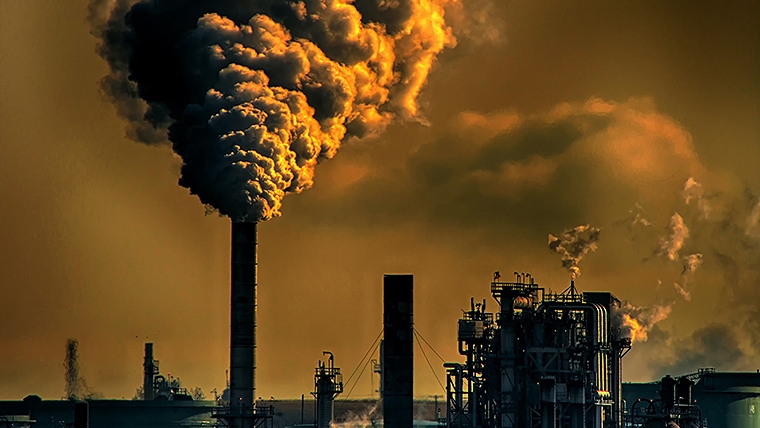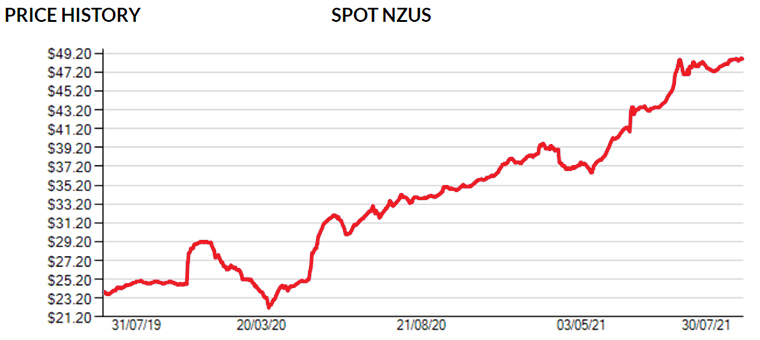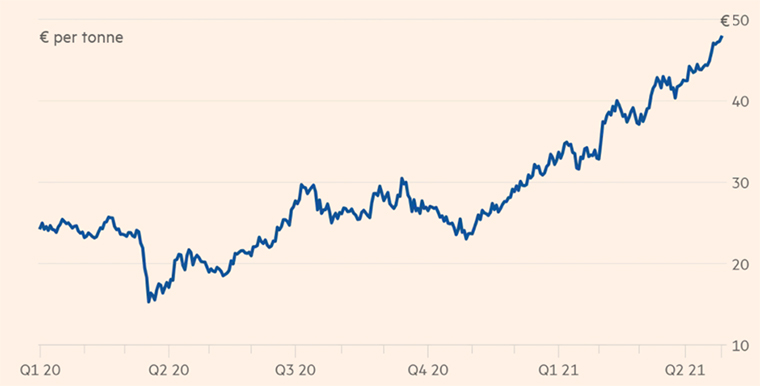
With the New Zealand carbon price bouncing around the $48 per tonne mark post the June auction it is worth looking a bit closer at the market and how it is likely to impact upon New Zealand emissions and government liabilities.
The major issue looming for the next government auction of NZU’s credits, which is to be conducted in September, is whether or not the current $50 price cap is exceeded.
Currently government policy has a floor price of $20 per unit (1 unit equals the right to emit 1 tonne of CO2e) and a cap of $50. The cap is in place so that excessive volatile pricing does not occur and place undue pressure on sectors in the economy. However, with the NZU’s price already sitting at $48 it looks highly likely to threaten the cap price. If that happens then the government is able to draw on its reserves of “cost containment reserve units” to meet the extra demand and soften the NZU price.
Currently, the New Zealand government ETS auction system takes place four time a year (two have already taken place) in March, June, September and December. In normal circumstances 4.75 million NZU’s are put up for each auction (19 million in total) and in the two which have taken place so far all offered have been sold - in March for $36 and in June for $46 but the price is continuing to climb, currently at $48.60.

Source: Jarden Securities
The government (apparently) is not allowed to alter the auction settings within the calendar year and so the only way to control the price is to make more units available. So, the government has a fiscal budget for 7 million units which it is able to put onto the market in such, supposedly rare, situations. But still has to source the units from somewhere, likely to be from the EU trading scheme which trades internationally.
The problem is these are also experiencing rapid increases in value, currently worth around NZ$90 per unit. Both the Climate Change Commission (CCC) and other ‘experts’ have warned the government that they need to have a more relaxed policy around the cap and some have said it should be linked to the EU carbon price. This could avoid a budget blow-out in the upcoming auctions, presumably with the higher price it may also lead to reduce demand for credit.
The CCC recommended the Government raise the trigger for additional units from $50 to $70, with an annual increase of 10% plus inflation. To get to net zero, the carbon price could reach $140 per unit by 2030, the commission has said. Given the recent increases and with some sectors still to come into the ‘scheme’ there are plenty of upside pressures.

Source: Refinitiv
These select businesses, known as emissions intensive and trade exposed (EITE) entities, receive millions of free units from the Government every year. A 2019 Stuff analysis found just four companies - the Tiwai Point aluminium smelter, the Glenbrook steel mill, Methanex and Fletcher Building's cement arm - receive three quarters of free allocation.
Reforms to the ETS in 2020 that introduced auctioning also began to phase out these free units, but at a glacial rate of -1% a year for the next decade, then -2% a year through the 2030s and -3% a year until 2050. So, agriculture is not the only sector that has beneficial treatment in the ETS.
The New Zealand carbon price is showing a similar pattern to the EU’s and as the EU’s climbs the politicians there are looking to provide further protection to their own industries from imports from countries with ‘weaker’ carbon reduction policies and to help prevent ‘leakage’ from the EU itself to other developing countries.
A new Carbon Border Adjustment Mechanism, or CBAM, is likely to be the most likely tool to penalise those beyond the EU's borders.
The CBAM is aimed for non-EU companies exporting to Europe to pay the same price for their carbon footprint in Europe as European companies. The CBAM looking to be somewhat contentious especially to countries like China who while having a form of an ETS program is more limited than the EU’s and priced a lot lower at the moment.
Like what you read? Support our journalists. Find out how.
Currently the USA also does not favour the CBAM which provides developing countries some protection. China remains the world's larger greenhouse gas emitter, with 27% of total carbon emissions globally with coal still supplying more than 70% of China's electricity needs.
The EU is considering restricting the ‘border tax’ to cement, iron and steel, aluminium, fertilisers and electricity, and a lead in period of up to 2035 before it is implanted in full. So, at this stage New Zealand does not have to worry to much about meeting the EU criteria.
In reality by 2035 the New Zealand ETS is likely to be very close to the EU’s in value and coverage. Currently the EU ETS policy does not effectively include agricultural emissions of which make up about 10% of their total. Since 1990 their agricultural emissions have reduced by about 20% but have stagnated in the last 10 or so years.
If the EU does want to achieve its (new) policies of reducing its net emission target by 2030 by at least 55% compared to 1990 levels to achieve climate neutrality target by 2050, it is hard to not see their agriculture being included at some time in the future.
Back home, the impact of the ETS on reducing GHG emissions is predicted as having limited success with its influence only reducing emissions by 15%. Although, Treasury believe that it will still have a major impact. However, they seem to be standing alone with this view and most experts, the Minister for Climate Change Shaw and the CCC believe that all or at least more reduction policies are required to get the reductions required.
This is also consistent with international experience. Only when the ‘catch’ is broadened and the price of carbon goes up will any real progress be seen.
P2 Steer
Select chart tabs
22 Comments
So the whole carbon market is a fabrication?
Created to allow large parts of society to "mitigate" the consequences of their consumption without actually forcing them to modify their lifestyle?
And at the same time encouraging large overseas corporates to milk the system by planting pine trees and take the profits back overseas. While reducing local employment and reducing export earnings.
Agree until your last sentence.
By the time they've ACTUALLY mitigated their draw-down (of both the FF resource, and the sink-capacity to absorb the exhaust) vis-a-vis future generations; there will be no 'export earnings'. There will be full local employment, but my guess is that it'll be mostly re food-production. And it my not be equated with 'income'.
Looking forward I see a century of transitioning off fossil fuels until green house gases are in equilibrium.
After that that the control mechanism could be carbon credits and with a low population ,relative to land area, we are well placed to export carbon credits, replacing beef and dairy probably.
An advantage of Carbon Credits is they don’t need shipping and storage.
A bright new future beckons…
A webinar recently on NZ Ag sector energy overview going forward showed exponential growth in electricity usage. With Huntly reliant on coal and currently providing approx 28% of NZ power if the predicted growth in electricity consumption comes about, the bright future will be a power generators wet dream. Whether or consumers feel so excited about it all when they pay their power bill may be a different thing entirely. Electric power poverty is already an issue for some in NZ's 'caring, be kind' society.
Sometimes those who are part of NZs elite society need to walk in anothers shoes.
Be interested to watch that , if you have a link.
Huntly coal use is a bit of a catch 22 situation. Presumably short term , so not much point investing to improve or adapt , but bad optics / emissions in the short term.
Buy Meridian, Contact and Mercury
No link sorry, it was an event run by Businessnz.org.nz: Energy Scenarios for the Agriculture sector.
https://www.nzherald.co.nz/business/genesis-energy-and-tilt-renewables-…
Carbon price driving change
I know a dairy farmer who has been approached to sell their farm to a solar farm company. Change is coming.....
A dairy farm, over 100ha, on Dargaville town boundary, has just been sold to a solar farm.
Interesting to note it is only about 10 kms from a a proposed wind turbine farm.
That is a lot of electricity being fed into the network north of Auckland.
110ha is apparently preferred minimum size.
I believe the "fabrication" or watering down if you like , was to gain multiparty support , to ensure any changes last longer than a 3 year election cycle.
Funny about the planting being large corporates. We are run off our feet with farmers planting their land or buying other land and planting. They are rapt to finally be able to make a profit and set them and their families up with carbon and timber. These are 3 and 4th generation farmers.
Wilco, I have a totally different view and that is that farmers can increase their income on very marginal land and use that money to better utilize their good land. I see it as a transfer of funds into the local economy as money is spent in the same way as lamb and beef income is used. Also as far as I am aware 'overseas corporates' can not plant forests just for carbon, only as production forest. Current land owners are in the box seat for carbon forests which will enable better financial out comes for hard pressed hill country farmers.
Well at higher carbon prices change will start to happen - Coal will be the first off the blocks - look at all the companies planning to stop burning it and use electricity/biomass. Yes I hear the "coal to make electricity" but the higher carbon price is going to price that off the market very quickly. There is huge pain for anyone selling this power - the cost will induce change.
This change is coming, perfect or imperfect, its being driven by our markets and investment $$ - in a big way - doing nothing is as not a viable option if you want a place at the table. As the carbon price goes up the pain will get to much and it will drive change - the sooner the price goes up the sooner the problem will be solved.
While the NZ government continues to distribute "free" carbon credits to the big emitters there will be minimal change.
And I understand as a country we are importing more coal than ever.
Commitments to phase out coal by companies such as Fonterra are more about public perception and PR spin than financial pressure.
I agree we have to modify our past practices but mitigation is the wimps way out, the only upside being increased employment through bureaucratic complexity.
And even Shaw in previous statements acknowledges the limited impact of such schemes.
Its not spin as the carbon price goes up - its on the bottom line big time and if you push the carbon price higher the change will come faster. Put up Petrol by $1 per litre and people would be changing habits and behavior very quickly and use would fall. Free credits are reducing. Fonterra and others are moving as the costs rack up and they see what is coming if they burn coal. Next everyone will be moaning about higher fuel prices
Higher fuel 'prices' = higher everything prices.
Food is inextricably intertwined with fossil energy....... so is everything else
If fossil fuel gets more expensive other methods will become more competitive and with greater adoption will come down in price with innovation and scale.
The food you buy in a supermarket is linked to fossil fuels because of extraction and transport costs.
Not so much the seeds you put in a veg garden and fertilise with the kitchen compost..plus some seaweed supplement
How significant is the Huntley power station in this market? How much is Genesis spending per annum on these things?
At the current carbon price it adds around $100 per tonne to the coal price - the power companies are hurting big time and will be moving to get away from Huntly as fast as they can. Price does work and it will drive change which everyone talks about and thats about it until they have to pay - then action starts.

We welcome your comments below. If you are not already registered, please register to comment
Remember we welcome robust, respectful and insightful debate. We don't welcome abusive or defamatory comments and will de-register those repeatedly making such comments. Our current comment policy is here.